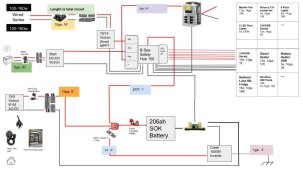I'd appreciate more experienced eyes reviewing my schematic. I'm a beginner, but have been researching a lot.
Where
Install will be in the back of a truck, simple cab canopy camper.
Why
Fairly simple back of truck camping for hiking/fishing/hunting; lights, refrig, diesel heater, phone/laptop recharg, occasional mini-instapot or induction cooktop when power rich. 200ah should be plenty
Priorities are safety, reliability and ease of use, compact footprint that can be easily contained and removed (with exception of the blue seas fuse box and circuits)
In PNW, expect to rely mainly on DCDC, but get some solar assistance in summer.
Equipment
Circuit lengths are overestimates.
Items I have- SOK 206ah battery, victron MPPT 75/15, victron IP 65 charger, victron BMV 712, Blue Sea Safety Hub 150.
Undecided:
I may put the inverter right next to the battery and minimize circuit length, depends on where it fits the best.
I may downgrade to a 1000W inverter, I'm not sure if the SOK can handle a 1500W inverter. Max loads would generally be 800-1200W (rare induction cooktop). If I move it closer, I can likely downsize from 2/0.
Still waiting on solar panels until done with rack to see exactly what fits best, I can change the MPPT if I'm too overwatted for the 75/15.
Questions:
I'm still confused on MRBF vs class T fuse vs other for immediate fuse leaving battery. I'd like compact and not to spend more than needed, but obviously safe
If I spec out a 150-200a fuse near the battery, do I need a separate fuse going to the inverter if I don't have a downsize in wire?
Are 3 connections on the blue seas disconnect switch too many, should I branch to a power post?
Any other glaring problems?

Thanks
Where
Install will be in the back of a truck, simple cab canopy camper.
Why
Fairly simple back of truck camping for hiking/fishing/hunting; lights, refrig, diesel heater, phone/laptop recharg, occasional mini-instapot or induction cooktop when power rich. 200ah should be plenty
Priorities are safety, reliability and ease of use, compact footprint that can be easily contained and removed (with exception of the blue seas fuse box and circuits)
In PNW, expect to rely mainly on DCDC, but get some solar assistance in summer.
Equipment
Circuit lengths are overestimates.
Items I have- SOK 206ah battery, victron MPPT 75/15, victron IP 65 charger, victron BMV 712, Blue Sea Safety Hub 150.
Undecided:
I may put the inverter right next to the battery and minimize circuit length, depends on where it fits the best.
I may downgrade to a 1000W inverter, I'm not sure if the SOK can handle a 1500W inverter. Max loads would generally be 800-1200W (rare induction cooktop). If I move it closer, I can likely downsize from 2/0.
Still waiting on solar panels until done with rack to see exactly what fits best, I can change the MPPT if I'm too overwatted for the 75/15.
Questions:
I'm still confused on MRBF vs class T fuse vs other for immediate fuse leaving battery. I'd like compact and not to spend more than needed, but obviously safe
If I spec out a 150-200a fuse near the battery, do I need a separate fuse going to the inverter if I don't have a downsize in wire?
Are 3 connections on the blue seas disconnect switch too many, should I branch to a power post?
Any other glaring problems?

Thanks


